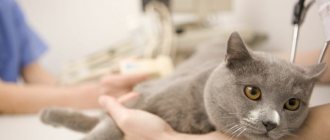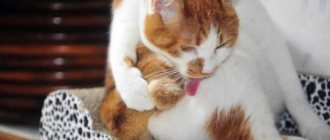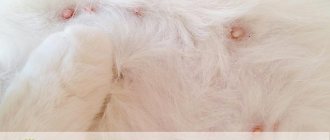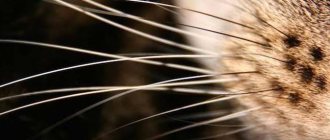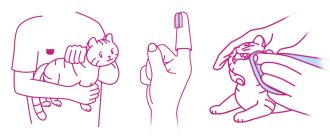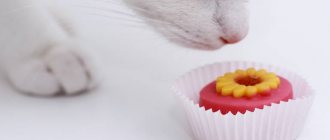- Factors contributing to inflammation
- How does inflammation of the anal sacs manifest in a cat?
- Treatment of the inflammatory process of the paraanal glands
- What can a pet owner do?
Inflammation of the anal sacs in cats is an infectious disease that many pet breeders face. It is typical mainly for purebred animals, which over time have lost the ability to independently empty their anal sacs of secretions. The fluid accumulated in the paraanal glands causes the latter to overflow, causing them to sharply increase in size, which significantly complicates the normal act of defecation in the animal and even prevents it from walking. To prevent this from happening, the cat owner needs to periodically help his pet and carry out a simple procedure for cleaning the animal’s paraanal glands with his hands every few months.
When do cats and dogs need to have their anal glands cleaned?
Usually these glands are completely cleared when stool is released. This is a natural process and there is no need to interfere with it.
But in some cases they can become clogged, and then the normal removal of secretions from the pet’s body is disrupted. If the bags are overfilled, the well-being of the “tail” deteriorates sharply. In such a situation, an urgent visit to a veterinarian is necessary. If treatment of the inflamed organ is not started in time, pathogenic bacteria begin to multiply in it. An infection gradually develops, which can result in suppuration.
The most common causes of blockage of the paraanal glands are:
- inflammatory process;
- genetic factor;
- diseases of the digestive system;
- constipation;
- helminth infection;
- infection;
- improperly formed dog diet with a predominance of protein foods or bones;
- lack of hygiene;
- weakening of the body's defenses.
Most often, the problem with gland blockage occurs in pets of small breeds (pugs, Pekingese, dachshunds, Shih Tzu, Spitz, etc.) They move too little, which is why their feces soften significantly, disrupting the normal process of bowel movements. Most often the disease affects pregnant and lactating females.
Prevention
To prevent the development of inflammation of the paraanal glands, you must adhere to the following rules:
- Watch your pet's diet; foods should not cause constipation.
- Do not overfeed your cat so that he does not become obese.
- Get checked regularly by your veterinarian.
- Inspect your pet's anus regularly at home.
- Removal of anal glands is a procedure that is prescribed for frequent inflammation.
- Monitor your cat's condition and consult a doctor if there are any changes.
How to understand that the anal glands are full
The main signs of overflow of the paraanal glands in dogs and cats are pain and discomfort, so the owner needs to pay attention to the pet’s behavior. If an animal constantly bites its hind legs, frequently licks its anus, tries to catch its tail, or rubs itself on the floor, you should show it to a specialist. Symptoms of blockage of the paraanal glands are also a fishy smell emanating from the tail, redness of the anus and difficulty defecating. As the disease progresses, an abscess sometimes develops, from which blood and pus flow out upon opening.
In total, there are four stages of blockage of the paraanal glands:
- The total amount of secretion decreases sharply, and the pet begins to experience severe itching.
- The liquid inside the sacs thickens greatly, causing it to become compacted. At this time, spasms of the animal’s hind legs are often observed.
- The secretion of the gland stops draining naturally. An infection develops, followed by inflammation. Your pet may experience acute pain when defecating.
- The duct is completely blocked, and the pet develops an abscess of the paraanal gland. His body temperature rises and his general health deteriorates significantly.
Symptoms
When the outflow of secretions is disrupted, excess fluid accumulates in the anal sacs. They increase in size, which causes severe discomfort to the pet.
Owners may notice the following signs of inflammation:
- constant licking;
- restless behavior;
- change in gait;
- anxiety during defecation, because this process causes pain in the cat;
- refusal to eat;
- the pet does not allow you to touch the back of the body;
- sometimes blood in the stool;
- increase in body temperature.
To make sure of the diagnosis, you need to show the cat to a specialist. You can first examine the anus area yourself. You will be able to detect swelling on one or both sides; when pressed, the animal experiences pain, while with gentle squeezing, a light yellow liquid with an unpleasant odor is released from the glands; the more advanced the disease, the darker the secreted liquid.
Is it possible to check on your own whether your pet’s sinuses are blocked?
When the anal sinuses are in normal condition, they are empty and feel soft to the touch. You should wear sterile rubber gloves and carefully insert your finger into the anus and examine its walls in search of seals.
Of course, this is not the most pleasant procedure for both the owner and the pet. And if you are not a professional, you can press too hard and harm your pet’s health. Therefore, it is better to consult a doctor or grooming specialist.
Symptoms of the disease
Late diagnosis and treatment of this pathology provokes serious complications in the animal’s body. There are three main signs of perianal inflammation in cats.
They are as follows:
- The animal regularly licks and bites at the base of the tail;
- The cat begins to scratch the anus on the floor surface;
- While moving, the pet begins to limp. His gait may appear wobbly and hopping.
There are a number of additional symptoms of paraanal inflammation in cats. These include:
- The tail is constantly pressed to the anus;
- The animal emits a foul odor that does not disappear after bathing with detergents;
- The cat's anus appears dirty and swollen in appearance;
- The animal's appetite sharply decreases and its health deteriorates.
The inflammatory reaction is most often accompanied by the appearance of high temperature. When initial symptoms appear, it is recommended to carefully examine the cat's anus.
If swelling, a pungent odor and redness of the mucous membranes appear, you should immediately contact a veterinarian.
What happens if you do not contact a veterinarian in time if there is a pathology?
Don't think that the problem will solve itself. As we have already said, the accumulated secretion in the anal sacs becomes an excellent breeding ground for the proliferation of pathogenic bacteria. If clogged anal glands are not cleared, your pet will require lengthy and complex treatment.
Signs of a worsening situation are:
- pain experienced by the pet during bowel movements (he may whine, grunt, etc.);
- hair loss;
- redness of the tissues near the anus;
- wet areas;
- presence of fistulas;
- swelling in the anal area;
- presence of irritation, etc.
In such cases, the animal needs urgent help from a specialist. You cannot clean the anal glands yourself!
Reasons for violation
Inflammation of the paraanal glands as a result of their blockage is more often diagnosed in males who lead an inactive lifestyle. Inflammation of the perianal glands is most often recorded in young pets with long hair. There are several factors that provoke the development of the pathological process.
The main ones are:
- disturbances in the diet, which subsequently provoke systemic changes in the intestines (dyspeptic disorders - systemic constipation or diarrhea);
- an increased content in the cat’s diet of various cartilages and small bones, which contribute to disturbances in the process of excretion of feces;
- pathologies of metabolic processes that provoke weight gain and obesity;
- mechanical injuries in the anal area that violate the integrity of tissue structures (the resulting wounds and their improper treatment can provoke inflammatory processes);
- parasitic diseases - intestinal helminthiases are a common cause of inflammation in the intestinal wall and rectum;
- period of gestation of kittens.
Disruption of the normal release of specific secretions from the perianal glands provokes the onset of inflammation and swelling. At the same time, the glands enlarge and cause discomfort to the animal. Inflammation of the anal glands in a cat occurs as follows:
- there is a disruption in the release of secretions from the glands, causing overcrowding of the bags;
- the secretion accumulates and acquires a dense consistency, causing itching sensations;
- in the process of mechanical action (the animal tries to rub the itchy spot), which results in infection with pathogenic bacterial microflora;
- the affected area increases in size, which ultimately causes the formation of an abscess with further rupture and the release of foul-smelling exudate;
- The animal's body temperature increases, its general condition worsens, apathy and lethargy are observed.
It is important to promptly recognize the onset of the pathological process, since as a result of rupture of an abscess formed in the anal glands, the development of sepsis and even death is possible. If acute inflammation is not treated in a timely manner, it can become chronic. It is not possible to cure chronic inflammation of the paraanal glands in a cat.
Appointment with a veterinarian in advanced cases
The doctor will examine your pet and prescribe the necessary tests. Usually a general blood test is required, but sometimes the contents of the anal glands and skin scrapings are also taken for analysis.
Based on the research results, the specialist will determine a treatment regimen and give the owner recommendations for treatment and prevention of relapse of the disease.
Usually it is enough to thoroughly clean and rinse the glands, treat the surrounding tissues with disinfecting compounds, and then give the pet a course of therapy with antibacterial and painkillers. To prevent infection in the postoperative area, a veterinary collar is placed on the pet’s neck.
Deep cleaning of the glands is carried out without general anesthesia using local anesthesia. The patient is immobilized and the procedure is carried out carefully.
If the inflammatory process has progressed far and complications have arisen, drainage may need to be installed or surgery to remove the anal glands.
Dogs should be taken for walks more often during treatment. Any abstinence from bowel movements can cause constipation and impair tissue healing.
The owner also needs to provide the pet with a special diet of fiber-enriched, easily digestible foods. Ideally, make an appointment with a veterinary nutritionist.
Treatment
Treatment of the inflammatory process in the anal glands requires an integrated approach and only in a veterinary clinic. A qualified doctor conducts a detailed examination of the pet, assessing the severity of damage to tissue structures in the anal area.
Based on the data obtained, therapeutic measures are carried out. The basis of treatment in the initial stages of pathology is cleaning the cat’s paraanal glands mechanically. The specialist also provides instructions to the owner regarding the further organization of care for the animal.
Self-treatment at home is not recommended without consulting a doctor, as there is a high risk of starting a pathological process, which will lead to serious problems - an abscess of the paraanal glands in a cat (a condition that can only be eliminated surgically).
After treating the anus with an antiseptic, the veterinarian performs manual cleaning of the glands. After complete devastation, the affected area is re-treated with antiseptic solutions. It is recommended to apply a special ointment with an antibiotic to prevent the development of pathogenic bacterial microorganisms. Pain in the animal is relieved using novocaine blockade.
The number of procedures for cleaning the anal sacs necessary for a complete recovery is determined by a specialist, based on the degree of neglect of the inflammatory process and the condition of the animal itself.
Severe cases of anal gland inflammation require deeper cleansing. If the clinical case is complicated by an abscess of the anal glands, fistula, or even rupture of the glandular sacs, resection is necessary. Removal of the anal glands is carried out under general anesthesia and is associated with a large number of complications.
Thus, there is a high risk of damage to the animal’s sphincter, which ultimately leads to fecal incontinence. After surgery, the patient is prescribed broad-spectrum antimicrobial drugs. The course of antibiotic therapy ranges from 5 to 7 days, depending on the condition of the sick animal.
In case of complicated inflammation, to prevent the development of an abscess, the cat is prescribed ointments applied to the anus. It could be Levomykol or Levomycetin. It is possible to apply Streptocide ointment to the anus. It is necessary to regularly wash the affected area with antiseptic solutions using a syringe without a needle and apply ointments for at least 4 weeks.
Veterinary experts recommend using vitamin preparations to strengthen the body’s defenses and the ability to resist pathogenic microflora. In addition to the general strengthening effect, this type of biologically active additives promotes the rapid regeneration of damaged skin.
It is worth noting that cleaning the anal glands in animals that do not suffer from inflammation is prohibited, as this may disrupt their normal functioning. It is better not to interfere with physiological processes unless necessary. It is better to take measures to prevent inflammation of the perianal glands than to continue to treat the disease.
Prevention of disease after treatment
You need to visit a veterinarian at least once every six months. The anal glands should be cleaned only when indicated. The groomer or doctor will first conduct an examination, and only if the presence of blockage of the paraanal glands is confirmed, will he carefully empty the sinuses.
Other equally important methods for preventing sinus blockage are:
- fight against excess weight, if any;
- deworming;
- taking care of your pet's hygiene;
- tracking the frequency of his bowel movements;
- intensive walks with dogs or active games with cats;
- regular feeding of a balanced diet.
If you follow all the doctor’s recommendations, the animal’s intestines will begin to empty normally. The pet's condition will remain stable and no additional cleaning will be required. Feces passing through the anus will put pressure on the paraanal glands, and secretions from the sacs will freely release into the external environment during defecation.
Is it necessary to clean the paraanal glands of a pet just like that, for prevention?
No: the process of secretion extraction should normally proceed without outside interference. Any pressure on the sinuses and artificial emptying of the glands without medical indications can only cause harm. It is strictly forbidden to interfere with natural processes if they proceed normally without pathologies.
Our specialists carry out cleaning only when necessary, which is communicated to the owner after the examination and/or procedure.
Owners need to know about the existence and principles of operation of the paraanal glands in order to promptly suspect irregularities in their work and promptly seek advice. We categorically do not recommend mechanical cleaning without indications.
Treatment of inflammation of the paraanal glands in cats
1) If the inflammation in the gland is mild, cleaning the glands followed by suppositories or ointments for rectal administration with antibacterial and anti-inflammatory properties can help. In case of severe inflammation, the gland cavity can be washed with medications, followed by the introduction of an antibiotic into it. Then periodically you need to carry out preventive cleaning of the glands to avoid re-inflammation. Their frequency depends on the rate of accumulated secretion and the ability of the gland to cleanse itself. This can be from several times a month to 1-2 times a year.
2) In case of purulent inflammation (abscess), the veterinarian opens the cavity, treats it with antibacterial agents and, if necessary, drains it. To protect the gland and prevent the cat from possibly eating the medications used to treat the wound, an “Elizabethan collar” is put on the animal during treatment.
3) Sacculectomy is the surgical removal of the gland. This operation is used for congenital pathologies of the glands, often recurrent inflammation, and if neoplasia is suspected.
